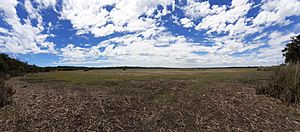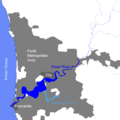Beeliar, Western Australia facts for kids
Quick facts for kids BeeliarPerth, Western Australia |
|||||||||||||||
|---|---|---|---|---|---|---|---|---|---|---|---|---|---|---|---|

Thomsons Lake, Beeliar
|
|||||||||||||||
| Population | 7,454 (2016 census) | ||||||||||||||
| • Density | 653.9/km2 (1,694/sq mi) | ||||||||||||||
| Postcode(s) | 6164 | ||||||||||||||
| Area | 11.4 km2 (4.4 sq mi) | ||||||||||||||
| LGA(s) | City of Cockburn | ||||||||||||||
| State electorate(s) | Cockburn | ||||||||||||||
| Federal Division(s) | Fremantle | ||||||||||||||
|
|||||||||||||||
Beeliar is a suburb of Perth, Western Australia, located within the City of Cockburn. The name refers to the Beeliar people, a group of Aboriginal Australians who had land rights over the southern half of Perth's metropolitan area. The suburb contains the Thomsons Lake Nature Reserve.
"Beeliar" is a Noongar word that translates to "river" or "water running through". The suburb was named after an early settler-colonialist, Robert Menli Lyon, who recorded and interacted with the local Aboriginal group in the area circa the nineteenth century. Before European contact, the suburb was occupied by the Beeliar group of the Whadjuk nation, who are part of the broader Noongar language region. The Noongar peoples have Dreaming stories related to the creation of the landforms in Beeliar and had lore that outlined the maintenance and care of the land. Oral history records and archaeology account for the Beeliar-Noongar belonging to the Beeliar suburb and its neighbouring areas.
The region of Beeliar was also included in the Swan River Colony, which was the first colony not established for convicts. The suburb was first governed by Captain James Stirling. Following Stirling's retirement, Beeliar was part of the frontier wars. Beeliar was home to Yagan and his father, Midjegoorong, who were notable figures during this period.
From the twentieth century, the suburban boundaries of Beeliar were modified gradually. Bibra Lake, which was still a feature within the Beeliar boundary during this time, was a site for the Australian Women's Army Service station during World War Two.
Since the post-war era, Beeliar has undergone several council projects, such as the Wetlands Education Centre of Cockburn (established in the 1980s), and gradually developed into a modern metropolitan suburb by the 1990s. The 1990s were when the most modern changes to the Beeliar boundaries occurred, which partially split Beeliar’s region into a new suburb, Yangebup.
Since the 1990s, environmental and land rights concerns have been a local geopolitical issue. Beeliar citizens have voiced their concerns to the council about protecting the suburban geographic features, such as the various wetlands (including Thomsons Lake).
Demographics
According to the 2016 Census, 7,454 people are living in Beeliar. 1.7% identify as Indigenous Australians. There are more females than males, and the median age is 33.
One-quarter of Beeliar's residents identify as having English ancestry (25.3%). The majority were born in Australia (62.4%), with other countries of birth including England, the Philippines, New Zealand, South Africa, and Portugal. Although most of Beeliar's populace was born in Australia, only 36% had both parents born in Australia.
34.9% of Beeliar’s residents affiliate with Catholicism, which is higher than the state average (21.4%).
Less than 20% of Beeliar's populace has some university qualification, which is slightly lower than the national average (22%). 22.6% of those currently studying or involved in the education system in 2016 were in public primary schools.
The census reports 2,053 families in Beeliar, with an average of 1.9 children per family with children. The average amount of people per household is 2.9 people.
The majority of Beeliar’s population aged 15 or over are married (52.2%), with an additional 12.4% involved in a de facto marriage. The majority of families have one parent working full-time, and the other works part-time (26.3%).
Households have, on average. 2.1 vehicles.
The majority of Beeliar’s residents work full-time (59.6%), which is higher than the state average (57%). The most popular industries that they work in are hospitals (4.1%), primary education, supermarkets, aged care services, and iron ore mining.
The median household income is $2045 per week. The median monthly mortgage repayments are $2167. The median weekly rent is $400. Households with Indigenous people pay a median of $385 per week. They pay $2470 per month on mortgage repayments, which is 148% more than the national median for Indigenous Australians ($1660 per month).
Images for kids
-
Statue in Yagan Square, Perth of the historic warrior Yagan
-
The Australian Women's Army Service station near Bibra Lake, in 1944.







